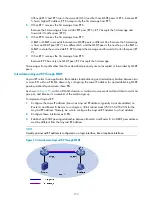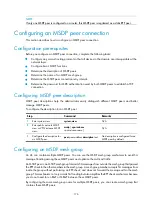
173
The working process of Anycast RP is as follows:
4.
The multicast source registers with the nearest RP. In this example, Source registers with RP 1, with
its multicast data encapsulated in the register message. When the register message arrives at RP
1, RP 1 de-encapsulates the message.
5.
Receivers send join messages to the nearest RP to join in the RPT rooted as this RP. In this example,
Receiver joins the RPT rooted at RP 2.
6.
RPs share the registered multicast information by means of SA messages. In this example, RP 1
creates an SA message and sends it to RP 2, with the multicast data from Source encapsulated in
the SA message. When the SA message reaches RP 2, RP 2 de-encapsulates the message.
7.
Receivers receive the multicast data along the RPT and directly join the SPT rooted at the multicast
source. In this example, RP 2 forwards the multicast data down the RPT. When Receiver receives
the multicast data from Source, it directly joins the SPT rooted at Source.
The significance of Anycast RP is as follows:
•
Optimal RP path
—A multicast source registers with the nearest RP so that an SPT with the optimal
path is built. A receiver joins the nearest RP so that an RPT with the optimal path is built.
•
Load balancing between RPs
—Each RP maintains part of the source/group information within the
PIM-SM domain and forward part of the multicast data, achieving load balancing between
different RPs.
•
Redundancy backup between RPs
—When an RP fails, the multicast source that previously
registered with the RP or the receivers that previously joined the RP will register with or join another
nearest RP, achieving redundancy backup between RPs.
Be sure to configure a 32-bit subnet mask (255.255.255.255) for the Anycast RP address. Namely, be
sure to configure the Anycast RP address into a host address.
MSDP support for VPNs
The interfaces on the multicast routers in a VPN can set up MSDP peering relationships between each
other. By exchanging SA messages between MSDP peers, multicast transmission in a VPN between
different PIM-SM domains can be implemented.
To support MSDP for VPNs, a multicast router that runs MSDP maintains an independent set of MSDP
mechanism for each VPN that it supports:
•
SA cache
•
Peering connection
•
Timers
•
Sending cache
•
Cache for exchanging PIM messages
One VPN is isolated from another, and MSDP and PIM-SM messages can be exchanged only within the
same VPN.
Protocols and standards
•
RFC 3618,
Multicast Source Discovery Protocol (MSDP)
•
RFC 3446,
Anycast Rendezvous Point (RP) mechanism using Protocol Independent Multicast (PIM)
and Multicast Source Discovery Protocol (MSDP)
















































